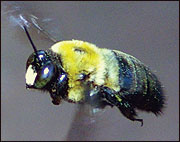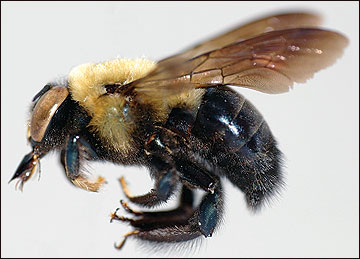The name carpenter bee applies to several species of bees in the United States that excavate tunnels in sound wood. The only species of economic importance found in Missouri is Xylocopa virginica (L.), a large species also known from Florida north to Connecticut, and west to Illinois, Kansas and Texas. They are similar in size and appearance to bumble bees (Bombus spp.), but with the top surface of the abdomen being black, almost entirely hairless, and shiny (Figure 1). Males have a white face, whereas the female’s face is black.
Carpenter bees are often seen hovering near decks, eaves and gables of homes. Homeowners may become alarmed by this activity because male carpenter bees patrol these areas and will fly near people. They defend territories and may be aggressive, but they are unable to sting, so their aggression is just a show. Female carpenter bees do not actively defend nesting sites and are usually not aggressive, but females can sting if they are handled.
 Figure 1
Figure 1
Adult carpenter bees (male, top; female, bottom) resemble bumble bees with shiny, black, hairless abdomens.

Biology and habits
Carpenter bees are normally considered to be beneficial insects because they pollinate a wide variety of plant species. However, when making tunnels in the wood of human structures, they are considered to be economic pests. The openings to these tunnels are a near-perfect circle measuring about ½ inch in diameter. The tunnel goes straight into the wood for a few inches before making a 90-degree turn and following the length of the wood (Figure 2). It is not unusual for several tunnels to extend out from a single opening.
Female carpenter bees construct individual cells within each tunnel. Each cell contains one egg and enough food for a developing larva. To make the food, she collects pollen and mixes it with plant nectar to form a substance called bee bread. She places the food into the tunnel, lays a single egg on it, and builds a partition in the tunnel with cemented wood chips. She continues this process until 6 to 10 cells are constructed.
The lifetime of a carpenter bee, from egg to death, covers one year. New adult bees emerge briefly in August or September, feed, and reenter their galleries to pass the winter. In the spring, those bees that survive winter emerge again in April, mate, and produce a new generation. They reuse existing tunnels or build new ones in which to lay their eggs. These adult bees die in July, after mating and egg-laying. Carpenter bee activity begins again when their offspring have matured and emerge briefly during September. Infestations may persist for several generations over several years, with each generation lasting a full year.
People may become alarmed when holes begin to appear in exposed wood. Unsightly defecation stains may also be present near the openings to carpenter bee tunnels. Although carpenter bees attack many species of dried, seasoned wood, they seem to prefer softwoods such as pine, fir, redwood and cedar. They may damage porch and shed ceilings, railings, overhead trim, wooden porch furniture, dead tree limbs, fence posts, wooden shingles, wooden siding, windowsills and wooden doors. They prefer unpainted or well-weathered wood to painted or hardwood timbers. Preferred nesting sites are usually at least 2 inches thick.
 Figure 2
Figure 2
Female carpenter bees tunnel and lay eggs in wood.
Management
Management of carpenter bee populations consists of treating each individual tunnel opening with insecticide. Tunnel openings should be treated after dark when the bees are calm and in the nest — preferably on cool nights. Use a pressurized can of bee/wasp spray that shoots a stream of liquid into the tunnel and immobilizes the bees. Many products are formulated to spray in a stream. Cotton soaked in a liquid insecticide and placed into the gallery is also effective. Be sure to wear rubber gloves when using this method. You can also place a longer-lasting insecticide — such as a dust, wettable powder, or microencapsulated insecticide formulation — inside the galleries. Dusts usually work best. Dust is most easily placed in the gallery opening using a hand duster. A flexible bottle with a nozzle makes an acceptable hand-duster. Fill the bottle no more than one-third full, insert the tip in the entrance hole, and inject the dust by alternately squeezing and releasing the pressure on the bottle.
A few days after treatment, tunnels should be filled with caulking compound, plastic wood, or a tight-fitting (½-inch) wooden dowel glued in place. If paint would be acceptable on the wooden surface, painting it will discourage further attack by other carpenter bees.
Spring
Consider treating tunnel openings in the early spring before bee activity begins. Spring treatment is best and most effective before mating and egg-laying activity begins. When you treat tunnel openings before activity begins, wait until the bees have become active for a few days before you fill the tunnels.
If mating, tunneling, and egg-laying activities have already begun in the spring, you will need to treat the tunnel openings at least twice. The first treatments occur during the spring activity period. These treatments eliminate the adults that are mating and building new nesting sites, but may not affect the eggs and larvae that are already developing inside the brood chambers. A second treatment can be made to the tunnel openings during the late summer activity period to ensure that adults that emerged from these larvae are also eliminated. Tunnels can be sealed after this second treatment.
Fall
When carpenter bees are discovered during the brief activity period of late summer and early fall, a single treatment can be applied to tunnel openings with good results. Treating tunnel openings during this period can be effective because only one generation of bees is present. Wait 24 to 48 hours after treatment before filling tunnels to ensure that adult bees have had time to be exposed to treated areas. If activity continues, you may reapply dust a second time before filling the holes.
Original author
Darryl Sanders, Department of Entomology